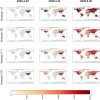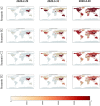The spatiotemporal estimation of the risk and the international transmission of COVID-19: a global perspective
- PMID: 33208858
- PMCID: PMC7676241
- DOI: 10.1038/s41598-020-77242-4
The spatiotemporal estimation of the risk and the international transmission of COVID-19: a global perspective
Abstract
An ongoing novel coronavirus outbreak (COVID-19) started in Wuhan, China, in December 2019. Currently, the spatiotemporal epidemic transmission, prediction, and risk are insufficient for COVID-19 but we urgently need relevant information globally. We have developed a novel two-stage simulation model to simulate the spatiotemporal changes in the number of cases and estimate the future worldwide risk. Simulation results show that if there is no specific medicine for it, it will form a global pandemic. Taiwan, South Korea, Hong Kong, Japan, Thailand, and the United States are the most vulnerable. The relationship between each country's vulnerability and days before the first imported case occurred shows an exponential decrease. We successfully predicted the outbreak of South Korea, Japan, and Italy in the early stages of the global pandemic based on the information before February 12, 2020. The development of the epidemic is now earlier than we expected. However, the trend of spread is similar to our estimation.
Conflict of interest statement
The authors declare no competing interests.
Figures









References
-
- Chan JF-W, Yuan S, Kok K-H, To KK-W, Chu H, Yang J, Yuen K-Y. A familial cluster of pneumonia associated with the 2019 novel coronavirus indicating person-to-person transmission: a study of a family cluster. The Lancet. 2020;395(10223):514–523. doi: 10.1016/S0140-6736(20)30154-9. - DOI - PMC - PubMed
-
- WHO. (2020). Coronavirus disease (COVID-2019) situation reports. https://www.who.int/emergencies/diseases/novel-coronavirus-2019/situatio....
Publication types
MeSH terms
LinkOut - more resources
Full Text Sources
Medical

